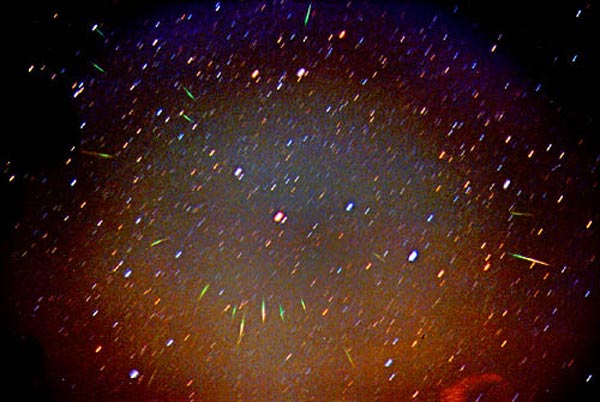
|
Credit & Copyright: Juan Carlos Casado
Explanation:
The 1999 Leonids meteor shower was not equally good for everybody.
Only observers in Europe and the Middle East with clear skies near
2 am (UTC) on 1999 November 18 saw rates
shoot up to a meteor every few seconds.
Above, however, is a picture taken from Spain
during this time, with over a dozen faint
meteors visible as
green streaks eminating from
Leo during just
a six minute exposure.
Although more numerous, the
1999 Leonids did not have the same
high proportion of bright meteors and fireballs as the
1998 Leonids.
Last year's Leonid fireballs
have been
traced back to the 1333 passage of
Comet Tempel-Tuttle.
The orbit of Jupiter continually deflected one stream of
cast-off particles while the smallest
meteors in
this stream were removed by light pressure from the Sun.
The remaining Leonids were relatively large,
pea sized or larger, compared to the sand-sized Leonids that are more common.
|
January February March April May June July August September October November December |
| ||||||||||||||||||||||||||||||||||||||||||||||||
NASA Web Site Statements, Warnings, and Disclaimers
NASA Official: Jay Norris. Specific rights apply.
A service of: LHEA at NASA / GSFC
& Michigan Tech. U.
Based on Astronomy Picture
Of the Day
Publications with keywords: Leonids - meteor - meteor shower
Publications with words: Leonids - meteor - meteor shower
See also:
- APOD: 2025 August 25 Á The Meteor and the Star Cluster
- APOD: 2025 August 6 Á Meteor before Galaxy
- APOD: 2024 December 10 Á The Great Meteor Storm of 1833
- APOD: 2024 November 27 Á The Meteor and the Comet
- Meteor over the Bay of Naples
- Quadrantids of the North
- APOD: 2023 December 17 Á Geminids over Chinas Nianhu Lake
